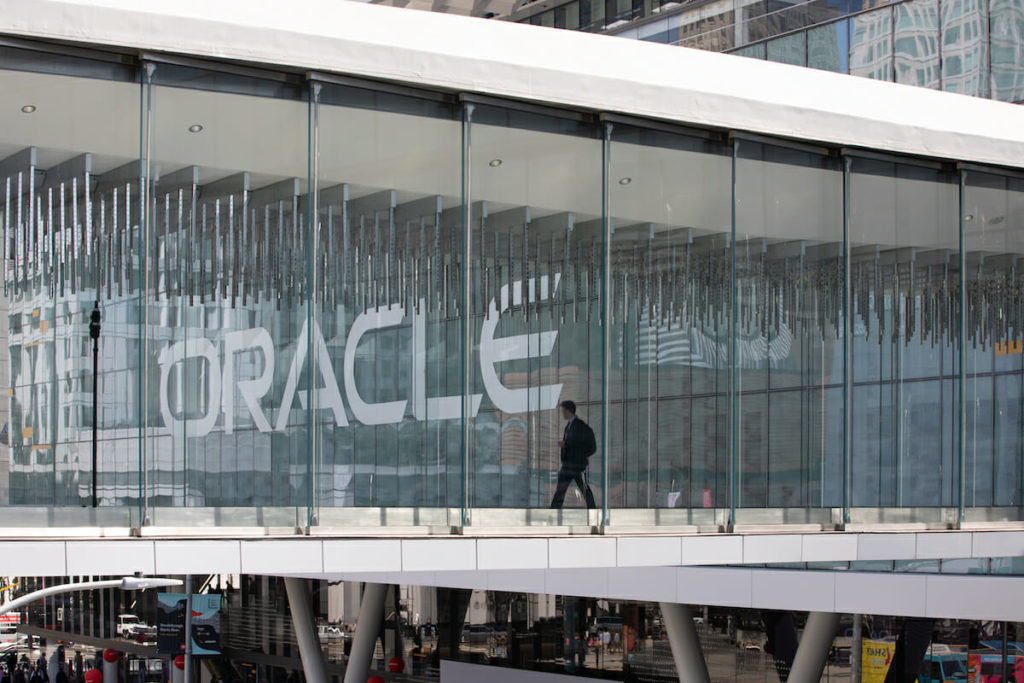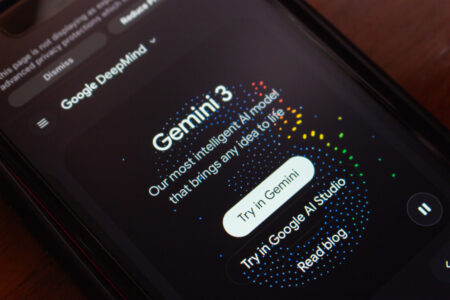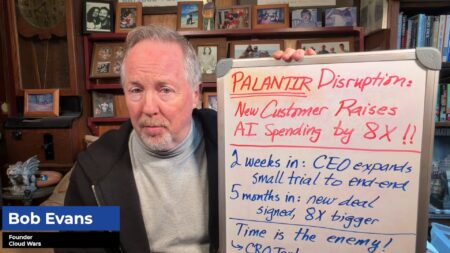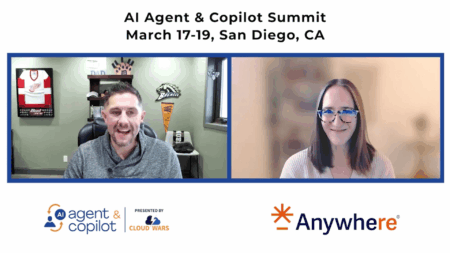When Oracle’s Q4 earnings come out on June 16, Larry Ellison will be sure to focus on his two bet-the-company cloud products, his efforts to shake up cloud definitions and his looming promise to snatch some big SAP customers.
Oracle’s fiscal Q4, ended May 31, is always Oracle’s largest. It also often reveals some developing trends for the company’s new fiscal year. In that context, I’m expecting Ellison to use the earnings call to hit hard on these five points:
- the rise of Oracle Autonomous Database, which still stands alone as the only self-driving enterprise database;
- the ongoing rapid growth of Oracle Cloud ERP, which Ellison has said can claim market share of more than 90%;
- without specifically describing it this way, Ellison’s very deliberate positioning of Autonomous Database as an infrastructure product cuts directly against traditional cloud-services categorization;
- the significant momentum of Oracle Cloud Infrastructure, which until recently barely registered on IaaS market-share breakouts; and
- perhaps an update in Ellison’s ongoing tale about how his Cloud ERP has peeled off, is peeling off, or will soon peel off some big SAP customers, a claim that SAP CEO has categorically denied. (Please see Oracle-SAP Showdown: SAP Calls BS on Larry Ellison Claim of Snatching Huge SAP Customer.)
Let’s take a look at each to get a sense of Ellison’s vision for where Oracle is and where it’s headed.
1. Autonomous Database.
Ellison has called the cloud-native database “the most-important product in the company’s history.” He’s also projected it will be the most successful. About half of Oracle’s revenue comes from database, and Ellison believes the majority of those customers—and perhaps even the vast majority—will switch to Autonomous. If that happens, Oracle’s position in the cloud business will become dramatically stronger. Because any business that wants Autonomous Database must also buy Oracle Cloud Infrastructure; the revolutionary database doesn’t run on anything else.
But so far, Ellison has not tied any revenue numbers to Autonomous Database. He has said that the business is growing so fast that it can’t be forecast and that its growth rate is “in triple digits,” but in these very early days, that’s not exactly illuminating. I suspect Ellison will offer some revenue numbers next week—otherwise, hype-fatigue could set in among the financial analysts. (For more on this, please see Can Larry Ellison Turn Zoom & Autonomous DB into Big-Time Oracle Cloud Revenue?)
2. Cloud ERP.
This fast-growing SaaS app, along with Autonomous Database, are the two products that Ellison, on multiple occasions, has said will determine Oracle’s future. In this broad category, Oracle actually has two distinct offerings: its own Cloud ERP, and also NetSuite ERP. While Oracle does not break out specific revenue for these businesses, Ellison has claimed that their market share dwarfs that of any competitor, and could be in the range of up to 95%.
This opens the door for swipes at SAP and Workday. Ellison will no doubt hit on each of them again, but the more-telling storyline would be the types of customers that are using Oracle’s Cloud ERP, and the business benefits they’re gaining from it. I hope Ellison will devote some time and attention to that angle on next week’s earnings call.
3. Blurring the lines between PaaS and SaaS.
By his very nature, Ellison always defies traditional wisdom. And over the past year or so, he’s begun to challenge the traditional structure of the cloud marketplace by putting his hotshot Autonomous Database in the category of IaaS rather than in the PaaS layer, which has always been the norm for cloud databases. I suspect that’s because Ellison wants to pump up his revenue and share in the high-visibility realm of IaaS, in which pioneer and category king Amazon Web Services, Microsoft, and Google Cloud are the major players. It also reflects the very tight coupling of Autonomous DB with what Oracle calls “OCI,” which stands for Oracle Cloud Infrastructure.
4. Oracle Cloud Infrastructure shows some teeth.
In Oracle’s fiscal-Q3 earnings call in March, Ellison—for the very first time—offered a detailed list of customers using OCI and explained how and why they’re using it. In the past, this was a category that Oracle worked hard to avoid because its presence was negligible among leaders AWS, Microsoft and Google Cloud.
But Oracle’s deep investments in what it calls its “Gen 2” infrastructure are beginning to pay off and its differentiated offerings in cybersecurity and performance are winning some customer momentum. And of course, the fact that Autonomous Database requires OCI has also been a huge help in driving growth for Oracle’s IaaS business.
5. Ellison has promised to convert some huge SAP customers to Oracle Cloud ERP.
For the past couple of quarters, Ellison—a master storyteller—has used Oracle’s earnings call to claim that his Cloud ERP app has so much momentum that a number of SAP’s biggest and longest-term customers are on the verge of tossing out SAP and installing Oracle Cloud ERP. But with each telling, the claims get a bit more vague. My hope is that Ellison will avoid the subject unless he’s able to share some specific names and details.
However, the Oracle-SAP wars have been raging for decades, and the latest battles seem to now be centered around which company can be more convincing in persuading existing on-premises customers to move to the cloud. As I noted above, SAP has flat-out denied that any of its big ERP customers are on the verge of jumping ship to Oracle. In fact, CEO Christian Klein recently told me that not only are none of his customers jumping to Oracle, but also SAP’s cloud ERP business has far more customers than Oracle’s. For more on that, please see SAP Has Twice as Many Cloud ERP Customers as Oracle: Exclusive Co-CEO Interview.
Final thought
Oracle’s numbers will reflect a 3-month period in which the COVID crisis fully emerged (March), rattled the global economy (April) and began slowly to recede (May). So on that short-term basis, Oracle’s fiscal Q4 report will scrutinized closely.
And while that’s clearly important, the more-strategic stories will be around Ellison’s willingness to disclose some revenue numbers and growth figures for Autonomous Database and Cloud ERP, and perhaps also some names of these big SAP customers.
Remember: in the Cloud Wars, the ultimate winners are the customers.
RECOMMENDED READING
Oracle-SAP Showdown: SAP Calls BS on Larry Ellison Claim of Snatching Huge SAP Customer
SAP Has Twice as Many Cloud ERP Customers as Oracle: Exclusive Co-CEO Interview
Can Larry Ellison Turn Zoom & Autonomous DB into Big-Time Oracle Cloud Revenue?
Who Will Acquire Zoom: Amazon, Oracle, or IBM?
The Zoom Revolution: 10 Eye-Popping Stats from Tech’s New Superstar
Global Recession Exposing Deep Flaws in Traditional IT: Workday CEO Aneel Bhusri
Google Cloud Helps Drive Triple-Digit Online Growth at Lowe’s
Salesforce Shocker: Its #1 Revenue Business Is “Platform and Other”
Disclosure: at the time of this writing, Oracle and SAP were among the many clients of Cloud Wars Media LLC and/or Evans Strategic Communications LLC.
Subscribe to the Cloud Wars Newsletter for in-depth analysis of the major cloud vendors from the perspective of business customers. It’s free, it’s exclusive and it’s great!








